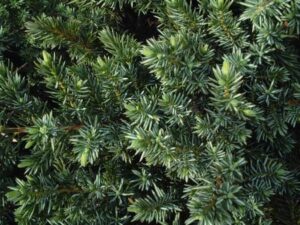S & J Nursery’s Guide to Growing
Blue Pacific Juniper / Shore Juniper
For the North Florida Jacksonville
| St. Augustine area Landscape
( Juniper Chinensis ‘Blue Pacific’ )
Blue Pacific Juniper Origins:
-Chinese Juniper
Blue Pacific Juniper Preferred Exposure:
– Juniper Blue Pacific or Shore Juniper will prefer full sun locations in the North Florida | Jacksonville | St. Augustine area landscapes. Although some varieties will tolerate very light shade, Juniper plants will tend to grow “leggy” and sparsely foliated when not receiving a full 6- 8 hours of direct
sun each day.
Blue Pacific Juniper / Shore Juniper Foliage:
– Lighter green almost silvery tinged blue green foliage has a soft appearance. Groundcover adds texture to the gardens landscape.
Blue Pacific Juniper / Shore Juniper Soil Preference / Salt tolerance:
– Blue Pacific Juniper / Shore Juniper will thrive in sandy well drained
soils.
– Blue Pacific Juniper / Shore Juniper has a high salt tolerance and is an
excellent choice to be planted as a groundcover on coastal properties.
– Drought tolerant landscape selection.
Blue Pacific Juniper / Shore Juniper Class Size Variance:
-Blue Pacific Juniper / Shore Juniper can reach sizes of 6-12 inches high
| 6-8+ feet wide spreading.
Blue Pacific Juniper / Shore Juniper Growth Habit:
-Low growing groundcover will spread along the ground or drape over the edge of a container or raised bed.
Blue Pacific Juniper / Shore Juniper Growth Rate:
-Blue Pacific Juniper / Shore Juniper shrubs are fast growing and will quickly establish itself in the landscape spreading a few feet by its second season after being planted.
Blue Pacific Juniper / Shore Juniper Water Requirements:
-Blue Pacific Juniper / Shore Juniper will quickly establish itself in the landscape with minimal care and is drought tolerant once established in the landscape.
Best Uses For Blue Pacific Juniper / Shore Juniper in the North Florida | Jacksonville | St. Augustine area Landscape:
– Perfect for use in hot spots in the lawn and landscape where other plants tend to suffer from drying breezes and full hot sunny locations.
– Use as the front of the border groundcover to create curves in the landscape bed around the foundation of your home or in island beds in the lawn.
– Perfect for raised beds and containers to add a trailing plant to spill over
the sides of retaining walls, pots, etc.
– Low maintenance landscape plant.
Care of S & J Nursery’s North Florida | Jacksonville | St. Augustine
Shrubs:
– Shrubs can be planted in the North Florida | Jacksonville | St. Augustine area at any time during the year. In normal and well draining soils dig the hole as deep as the root ball and two to three times as wide. Plant the top of the root ball level or slightly higher than the surrounding soils. When planting in poorly drained soils make sure to plant your shrubs a minimum of 3 inches ABOVE the surrounding soil level.
– Water every day during the establishment period. For most 3 gallon size shrubs in the North Florida landscape in average soil, that is neither heavy clay that holds water or really sandy that will take 2-3 weeks of daily watering to ensure that your newly planted shrub will begin to put out new roots and grow into its new home happily. After the first few weeks begin tapering back your watering to every other day then every third day and so on until your newly planted items are flourishing without your assistance.
– If planting larger shrubs you may need to extend the initial care a bit longer to protect your investment and get your shrubs off to the best start possible.
– IMPORTANT: If planting shrubs in heavy clay soils that hold allot of water after a rain or irrigating, remember to check the soil for moisture by sticking your fingers into the soil near the root ball of the newly planted shrub down to 2-3 inches. If it remains wet from the previous watering wait for the
top 2-3 inches to dry out before watering again.
– IMPORTANT: When planting shrubs into poor sandy soils be sure to amend the planting hole by mixing compost or cow manure etc. with the native soil that will go back in the hole around the new plants root ball when installing your shrub material, this will not only give your new shrubs good soil to grow its new roots into but help it hold water.
– When planting shrubs from containers be sure to loosen the roots as much as possible pulling loose roots away from the root ball before installing your new plants, if the roots are to tight to easily loosen with your hands use a knife to cut a few slits into the root ball being careful to go all the way from the top to the bottom and making the cut at least an inch deep. This will ensure that your plant will immediately begin to form new roots into its new surrounding soil.
– Mulch newly planted shrubs whenever possible.
– Fertilize each spring with a mixture of Milorganite and a slow release poly coated plant food such as Osmocote or Stay Green general purpose plant food, sprinkling the fertilizer around the mulch circle underneath the foliage of the tree
– Prune as needed to shape each spring and or summer.

